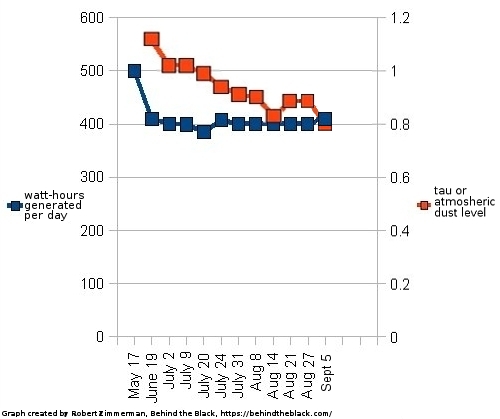Alison Krauss – Down to the River to Pray
An evening pause: Performed live 2002, when traditional American Christian gospel tunes were still considered mainstream instead of “white supremacy.”
An evening pause: Performed live 2002, when traditional American Christian gospel tunes were still considered mainstream instead of “white supremacy.”

The most recent status update on the Mars lander InSight, released today, shows a slight rise in the amount of power generated by its dust-covered solar panels.
As shown on the graph to the right, on August 27, 2022 the power level was 400 watt-hours generated per Martian day. On September, 5, 2022, the power level was 410 watt-hours per Martian day, the first power increase since late July. At the same time, the dust in the atmosphere continued to clear, going from a tau level of .88 to 0.8. Outside of the winter dust season tau is usually between 0.6 and 0.7.
The slight power increase continues to suggest that the lander’s death might be delayed. At 400 watt-hours per day, it has been able to run its seismometer since the beginning of July. With this slight increase, the chance increases that InSight will finally get that one gust of wind or dust devil that will blow the dust off its solar panels and allow it to recover some power and operate for longer.
On Christmas Eve 1968 three Americans became the first humans to visit another world. What they did to celebrate was unexpected and profound, and will be remembered throughout all human history. Genesis: the Story of Apollo 8, Robert Zimmerman's classic history of humanity's first journey to another world, tells that story, and it is now available as both an ebook and an audiobook, both with a foreword by Valerie Anders and a new introduction by Robert Zimmerman.
The print edition can be purchased at Amazon or any other book seller. If you want an autographed copy the price is $60 for the hardback and $45 for the paperback, plus $8 shipping for each. Go here for purchasing details. The ebook is available everywhere for $5.99 (before discount) at amazon, or direct from my ebook publisher, ebookit you don't support the big tech companies and the author gets a bigger cut much sooner.
"Not simply about one mission, [Genesis] is also the history of America's quest for the moon... Zimmerman has done a masterful job of tying disparate events together into a solid account of one of America's greatest human triumphs."--San Antonio Express-News
Cool image time! The photo to the right, rotated and cropped to post here, was taken on June 17, 2022 by the high resolution camera on Mars Reconnaissance Orbiter (MRO). The section highlighted is at full resolution, in order to make clear the absolutely crazy and complex terrain seen in the full image.
This terrain is not glacial, as the location is only about 1 degree south of the Martian equator. There might have been surface or near surface ice here once in the past, but there is none now.
Could we be looking at some form of lava flow? This is possible, because a close look at the context map at the image link suggests this region has been partly covered by some material, obscuring some craters to the east and west. However, there is no visible evidence anywhere in this region of a volcanic vent or caldera. If this covering material was volcanic it is very unclear where it came from.
The overview map below does not really provide any answers, but at least gives the context.
» Read more
Courtesy of stringer Jay.
Sadly, the video available is very short. I’ve looked for a longer version but was unable to find one.
From the tweet, “The local government has recently kicked off the land acquisition campaign.” Jay translated this more accurately, “The local government has recently kicked out people in the land acquisition campaign.”
Now available in hardback and paperback as well as ebook!
From the press release: In this ground-breaking new history of early America, historian Robert Zimmerman not only exposes the lie behind The New York Times 1619 Project that falsely claims slavery is central to the history of the United States, he also provides profound lessons about the nature of human societies, lessons important for Americans today as well as for all future settlers on Mars and elsewhere in space.
“Zimmerman’s ground-breaking history provides every future generation the basic framework for establishing new societies on other worlds. We would be wise to heed what he says.” —Robert Zubrin, founder of the Mars Society.
All editions are available at Amazon, Barnes & Noble, and all book vendors, with the ebook priced at $5.99 before discount. All editions can also be purchased direct from the ebook publisher, ebookit, in which case you don't support the big tech companies and the author gets a bigger cut much sooner.
Autographed printed copies are also available at discount directly from the author (hardback $29.95; paperback $14.95; Shipping cost for either: $6.00). Just send an email to zimmerman @ nasw dot org.
Capitalism in space: For what appeared to be an engine issue in the booster during the ascent phase, Blue Origin was forced to abort an unmanned New Shepard suborbital flight today.
I have embedded the live steam below, cued to just before the abort. It appears that something went seriously wrong with that first stage booster. The abort system immediately activated, separating the capsule and firing the capsule’s abort engines to take it safely away, with its parachutes bringing it down safely. That first stage booster was likely destroyed.
This particular suborbital flight fortunately was the first carrying no passengers since Blue Origin began commercial flights. Its payloads were a variety of experiments and commercial packages.
Regardless of the issue, Blue Origin will not be doing suborbital flights now for a considerable time, pending an investigation into this failure.

The Ukraine War as of August 30, 2022. Click for full map.

The Ukraine War as of September 11, 2022. Click for full map.
In the past week the Ukraine has scored a major victory in its effort to drive Russia from its territory, pushing the Russians back across a wide swath in the areas north and east of the city of Kharkiv. The two maps to the right, created by the Institute for the Study of War (ISW) and simplified, reduced, and annotated to post here, show these gains, with the top map from their August 30, 2022 analysis and the bottom from their September 11, 2022 update. Red or pink areas are regions controlled by the Russians. Blue areas are regions retaken by the Ukraine. Red-striped areas are regions captured by Russian in its 2014 invasion. Blue-striped areas are regions inside Russian-occupied territories that have seen strong partisan resistance.
The green lines on both maps mark rivers that act as important military barriers. The blue arrows on the lower map east of Kharkiv show the Ukrainian military push this past week, first to the east to the river Oskil. From there the forces moved north and south. To the south the Ukrainians used the Oskil river to their left as a wall protecting them from Russian forces. That same river acted to pin the Russians down in the south, forcing them in the past day to quickly retreat to the east across the one remaining bridge under their control, but in the process abandoning large amounts of armaments that the Ukrainians can now use.
In the south, the Dnipro River also acts as a barrier for the Russian occupying forces north of Kherson.
The Ukrainians have spent the last month or so aggressively attacking the handful of bridges that cross this river, thus restricting Russian transport to and from its northern forces. As the Ukrainians made these attacks, they were remarkably public about their plans to follow up with a major campaign in the south to retake Kherson and all territory north of the Dnipro.
In that public campaign lies the key to this whole counter-offensive. As ISW noted in its update of September 11, 2022:
» Read more
Leaving Earth: Space Stations, Rival Superpowers, and the Quest for Interplanetary Travel, can be purchased as an ebook everywhere for only $3.99 (before discount) at amazon, Barnes & Noble, all ebook vendors, or direct from my ebook publisher, ebookit.
If you buy it from ebookit you don't support the big oppressive tech companies and I get a bigger cut much sooner.
"Leaving Earth is one of the best and certainly the most comprehensive summary of our drive into space that I have ever read. It will be invaluable to future scholars because it will tell them how the next chapter of human history opened." -- Arthur C. Clarke
UPDATE: September 12th launch scrubbed due to weather. No word on when the next launch attempt will be scheduled.
Original post about September 11th scrub:
————–
After making two attempts, engineers at Firefly yesterday finally scrubbed the launch of their Alpha rocket, rescheduling the next attempt for today with a four hour launch window opening at 3 pm (Pacific).
Firefly has yet to make orbit. Their first launch attempt last year of Alpha failed when one first stage engine shut down prematurely due to a loose connection.
If you wish to watch the launch, I will embed the live stream below, once it goes live later today.
UPDATE: I have embedded the live stream below, with it beginning at 1:30 pm (Pacific).
» Read more
The lunar orbiter CAPSTONE, presently on its way to the Moon, went into safe mode on September 8th at the end of a mid-course correction engine burn.
The CAPSTONE mission team has good knowledge of the state and status of the spacecraft. The mission operations team is in contact with the spacecraft and working towards a solution with support from the Deep Space Network.
Under such conditions engineers almost always recover the spacecraft so that the mission proceeds as normal. No guarantees of course, but it is not unreasonable to expect the same with CAPSTONE.
Capitalism in space: SpaceX today successfully used its Falcon 9 rocket to launch 34 additional Starlink satellites into orbit. It also launched another customer’s communications satellite, AST Mobile’s BlueWalker-3.
The first stage successfully completed its record 14th flight, the most times a Falcon 9 first stage has been reused. It landed on a drone ship in the Atlantic. In addition, the two fairing halves completed their 4th and 5th flights, respectively. As of this writing, the satellites have not yet deployed from the upper stage.
The leaders in the 2022 launch race:
41 SpaceX
36 China
11 Russia
6 Rocket Lab
5 ULA
American private enterprise now leads China 56 to 36 in the national rankings, and the entire world combined 56 to 55. That U.S. lead stands a good chance of increasing this weekend, as tomorrow SpaceX plans another Starlink launch, but more significantly, Firefly will make the second attempt to complete the first launch of its Alpha rocket, almost a year after the first failed attempt.
The Defense and Commerce departments yesterday signed an agreement where Defense will help Commerce create its own capability for tracking of all objects in orbit, from satellites to space junk.
The agreement, the Commerce Department said in a statement, defines how the two departments will work together to implement provisions of Space Policy Directive (SPD) 3 in 2018 that directed commerce to provide space situational awareness (SSA) and space traffic management (STM) services, such as conjunction warnings, currently provided by the U.S. military.
The result of this is that the federal government is now creating a second bureaucracy to do what the military has been doing quite capably for more than a half century. Commerce intends to obtain its data by awarding contracts to private companies, who will do the actual tracking. The irony is that it is very possible the military will eventually sign similar contracts with the same companies, thus paying them twice for the same service. Meanwhile, Washington has an excuse for hiring more people.
Even more ironic, this policy directive was issued during the Trump administration. It might have intended for Commerce to replace the military, but under the Biden administration the federal bureaucracy is being allowed to interpret the policy more broadly, thus allowing both agencies to do the work.
I also guarantee that the Republicans will almost certainly do nothing to change this, should they take over Congress. For the past thirty years this so-called party of small government has done nothing to earn that title. Instead, it has simply engineered the growth of government, in a more subtle and deliberate manner.

Turf war! The FAA and the National Transportation Safety Board (NTSB) yesterday signed an agreement that divides up the responsibilities for investigating accidents that occur in or by space entities.
You can read that agreement here [pdf]. A screen capture of the key clauses is to the right. Essentially, the NTSB will lead any investigation that either causes death or injury, or involves damage to property not related to the space operation itself, while the FAA will lead all other investigations.
The agreement also has a lot of clauses describing how the two agencies will work together in dividing up this turf before, during, and after investigations. Above all, the agreement now authorizes both agencies to “conduct its own analysis and determine its respective conclusions and recommendations in accordance with its authorities.”
The agreement stems from an effort by the NTSB to take over all space-related accident investigations it proposed in November 2021 that both the FAA and industry strongly opposed. This agreement however shows that the Biden administration ignored those objections in order to give the NTSB a wider range of power, while also giving bureaucrats in both agencies more power as well. Under this agreement, every space incident is now going to be investigated twice, with both the NTSB and FAA doing their own investigations.
Expect this agreement to be used by the Washington bureaucracy to slow or shut down innovation and new technology. The NTSB is designed to investigate incidents caused in the long established and robust airline industry, not developing cutting-edge experimental work. It will naturally act to discourage such experimental work.
Meanwhile, the FAA will chime in with its own investigation and analysis. The competing results will only cause confusion and disorder, thus further acting to discourage any new and risky innovations.
Embedded below the fold in two parts.
To listen to all of John Batchelor’s podcasts, go here.
» Read more
Cool image time! The photo to the right, rotated, cropped, and reduced to post here, was taken on July 28, 2022 by the high resolution camera on Mars Reconnaissance Orbiter (MRO). It shows what the scientists label a “Circular and Banded Landform.”
I put this mesa into a geological category I dub “What the heck?!” We are clearly looking at a mesa, probably no more than 200 feet high, if that. What makes it baffling are the parallel bands that not only cut across the mesa but extend in the same direction for many miles in all directions. Though at first glance these bands appear to be dunes, their rocky eroded look along the mesa’s northwest rim suggests instead the bands are the top edge of many vertically oriented parallel layers, which at this mesa’s flanks are eroding alternatively at different rates.
The overview map below shows us where this mesa is located, relative to the south pole.
» Read more

They’re coming for you next: Her story is not unique in this age of blacklisting and oppression, but it does reveal how bad really things are because the source of the blacklisting happens to be a news outlet that many naively consider against such things. Breanna Morello had moved from Florida to take a new job with Fox News, with the expectation that it would not only get her on-air reporting time but might lead to becoming “a producer for Tucker Carlson.”
After packing up my beautiful Florida apartment in late December, I was relocating back to New York City for work. My remote role as a Fox Business booking producer was going to become an in-person position starting on January 3, 2022.
The day I moved into my new apartment, I was completely caught off guard by an email that was forwarded to me by my Executive Producer. » Read more
Capitalism in space: SpaceX yesterday successfully completed for the first time an eight-second-long static fire test of all six engines on Starship prototype #24.
I have embedded video of the test below. The amount of power exhibited is quite impressive. In fact, it was so powerful it likely melted the concrete below the rocket, sending hot debris flying that caused a major brushfire.
Most likely, eight long seconds of blast-furnace conditions melted the top layer of surrounding concrete and shot a hailstorm of tiny superheated globules in almost every direction. Indeed, in almost every direction there was something readily able to burn, a fire started. In several locations to the south and west, brush caught fire and began to burn unusually aggressively, quickly growing into walls of flames that sped across the terrain. To the east, debris even made it into a SpaceX dumpster, the contents of which easily caught fire and burned for hours.
Eventually, around 9pm CDT, firefighters were able to approach the safed launch pad and rocket, but the main fire had already spread south, out of reach. Instead, they started controlled burns near SpaceX’s roadblock, hoping to clear brush and prevent the fire (however unlikely) from proceeding towards SpaceX’s Starbase factory and Boca Chica Village homes and residents.
The rocket itself came though the test unscathed, a major milestone on the path to its first orbital flight.
During a launch, the rocket would have quickly lifted off, and thus caused far less stress to the concrete on the ground. Nonetheless, this test suggests SpaceX needs to do more pad preparation for any tests of Superheavy prototype #7, which has 33 engines at its base.
The FCC yesterday announced it is considering a new regulation that would require companies to de-orbit defunct satellites in low Earth orbit no more than five years after the satellite’s shut down.
The order, if adopted by commissioners, would require spacecraft that end their missions in or passing through LEO — defined as altitudes below 2,000 kilometers — dispose of their spacecraft through reentry into the Earth’s atmosphere as soon as practicable and no more than five years after the end of the mission. The rule would apply to satellites launched two years after the order is adopted, and include both U.S.-licensed satellites as well as those licensed by other jurisdictions but seeking U.S. market access.
According to the FCC press release [pdf], this new regulation will be discussed at the next public meeting of the commission on September 29, 2022.
Though in general this rule appears a good idea, there are several legitimate objections to it. NASA’s orbital debris office noted that this rule would only reduce space junk by 10%. Others questioned the FCC’s regulatory authority to do this at all, since its main statutory function is not the regulation satellite operations but the use of the frequencies those satellites use.
In outlining the status of the repair work on the hydrogen leak on SLS on the launchpad yesterday, NASA officials indicated that they are targeting a September 23rd launch date that will require the Space Force range safety office to okay the use of a flight abort system with batteries that are significantly past their use-by date.
NASA has submitted a request to the Eastern Range for an extension of the current testing requirement for the flight termination system. NASA is respecting the range’s processes for review of the request, and the agency continues to provide detailed information to support a range decision.
The range office had required that the batteries for that flight termination system be checked every 20 days, a process that requires the rocket to be rolled back to the assembly building. It had already given NASA a five day extension to 25 days, but even that was insufficient to get the rocket launched in its previous launch window, expiring on September 6th. Though NASA has not said how long an extension it is requesting, to do a September 23rd launch would require another extension of 17 days, making for a total 23-day waiver for those batteries. Thus, instead of limiting the life of those batteries to 20 days, NASA is requesting the range to allow the batteries to go unchecked for 43 days, at a minimum.
For the range to give that first waiver I think is somewhat unprecedented. To do it again, for that much time, seems foolish, especially as this will the rocket’s first launch, and a lot can go wrong.
NASA officials also hinted during yesterday’s press conference — in their bureaucrat way — that human error might have caused the hydrogen leak.
NASA has not confirmed if an “inadvertent” manual command that briefly overpressurized the hydrogen fuel line caused the leak, but the agency is investigating the incident. Bolger said new manual processes replaced automated ones during the second attempt and the launch team could have used more time to practice them. “So we didn’t, as a leadership team, put our our operators in the best place we could have,” Bolger said. During the Sept. 17 fueling test, NASA will try out a slower, “kinder and gentler” process that should avoid such events.
If the Space Force and the Biden administration demand the range officer allow this rocket, with this team, to be launched with a questionable flight termination system, we should expect public resignations from several range officers. Whether anyone in our present government however has the ethics to do such a thing appears very doubtful.
Courtesy of string Jay:
The press kit [pdf] says nothing about any attempt to recover the first stage.
This pad is intended to serve China’s pseudo-commercial rocket companies, thus isolating them from the government’s other higher security military and manned missions.
The mission will carry two Russians and one American, the American’s flight part of the new barter deal with Russia whereby each nation flies an astronaut on the other’s spacecraft.
As reporter Anthony Zak correctly notes, the “budget and timeframe for the project look dimmer than ever.”

The modern dark age: Despite a history during the 1950s McCarthy era, when many of its most talented members were blacklisted because of their leftwing political beliefs, Hollywood today celebrates and encourages the blacklisting of conservative talent.
Consider the blacklisting described by comedian Adam Carolla and late night Fox show host Greg Gutfield during one recent podcast:
“Oh, we can’t get the guys who wrote on ‘Conan’ to come into the writers’ room because they’re scared of being blackballed. It drives me insane that they never stop complaining about McCarthyism and they’re more than happy to blackball anybody who crosses the line,” Carolla said.
“They’re the new McCarthy-ites, especially in this woke culture,” Gutfeld said. “I’m counting on this show succeeding without names and creating our own celebrities, which is actually what happens at Fox.”
Both men also described how, even if a writer or performer wanted to work for them, they often backed out because their agent or publicist told them not to, either because of the same fear or because of hostility to their politics.
In addition, Carolla in a different podcast described how this same blacklisting culture is now being used not just against conservatives, but against those who refuse to bow to the absurd COVID edicts.
The story of one actor, Clifton Duncan, is typical.
» Read more
Embedded below the fold in two parts.
To listen to all of John Batchelor’s podcasts, go here.
» Read more

The landing zone for Luna-25 at Boguslawsky Crater
The head of Roscosmos, Yury Borisov, confirmed yesterday that the launch of Russia’s first lunar science probe since the 1970s has been delayed until 2023.
The Doppler speed and distance sensor made by the Vega Concern owned by the Rostech State Corporation, that could guarantee a soft landing, underperformed in terms of measurement precision, a source in the space industry told TASS in July. The launch will likely be postponed until 2023, the source added.
Russian sources had indicated in July that this delay was likely. Yesterday’s announcement merely made it certain.
This project has been under development for almost a quarter of century, which appears to be the average development time for government-run projects, whether in Russia or in the U.S. Just long enough to provide an almost entire career for bureaucrats.
An evening pause: I have posted scenes from this film twice (both sadly gone now from youtube), but I think the trailer sells it well. This movie remains one of the greatest made in the history of film. If you haven’t seen it, you must. Though its facts are of course not entirely accurate, its sense of the history, culture, time, and the political machinations going on in Arabia during World War I are spot on. The visuals, acting, and script (by Robert Bolt) are also magnificent.
It also speaks to the Middle East we see today, and helps explain why the Arabs have so far not really done well with the advantages of western technology.
Hat tip Tom Wilson, who says he makes it a point to watch this epic at least once a year.
Arianespace today used its Ariane-5 rocket, launching from French Guiana, to successfully place a Eutelsat communications satellite into orbit.
This was the fourth successful launch this year for Arianespace, so Europe still does not make the leader board. The company had predicted it would launch eleven times in 2022. At this moment it appears very questionable it will be able to match that prediction.
The leaders in the 2022 launch race:
40 SpaceX
36 China
11 Russia
6 Rocket Lab
5 ULA
American private enterprise still leads China 55 to 36 in the national rankings, but is now tied with the entire world combined 55 to 55.
Capitalism in space: NASA today awarded Axiom the contract to build the moonsuits the astronauts will use on the first lunar landing of its Artemis program, dubbed Artemis-3.
After reviewing proposals from its two eligible spacesuit vendors, NASA selected Axiom Space for the task order, which has a base value of $228.5 million. A future task order will be competed for recurring spacesuit services to support subsequent Artemis missions.
The contract award continues NASA shift from its failed spacesuit effort — taking fourteen years and a billion dollars to produce nothing — to hiring the private sector to do it.
Previously NASA had awarded contracts to both Axiom and Collins Aerospace to build spacesuits, either for spacewalks or on the Moon. Today’s award is specifically for moonsuits for that first lunar mission.
Though no details have yet been released, the engineering team for the Mars helicopter Ingenuity has posted the numbers for the helicopter’s 31st flight, which took place yesterday.
Ingenuity flew 318 feet to a height of 33 feet for 56 seconds. The maximum ground speed was 10.6 mph. The white dot on the map to the right indicates the approximate landing spot. The blue dot Perseverance’s location as of September 3rd.
The flight plan had been to fly 319 feet, so Ingenuity landed one foot short of that plan.
That difference does not indicate any problems. However, one of the present goals of the engineering team is to improve their landing accuracy in order to provide data for the future sample return helicopter that is now in development to come and get Perseverance’s sample cores. That future helicopter will need to be able to land very precisely, and they are using Ingenuity to refine the Martian flight software.

Cool image time! The photo above, rotated, cropped, and reduced to post here, was taken on May 13, 2022 by the high resolution camera on Mars Reconnaissance Orbiter (MRO), and shows two dramatic ancient flows of flood lava. The arrows indicate what I think is the direction of flow for each, though the direction of the flow to the north appears more certain. In a wider context camera image the bulk of the evidence suggests the southern flow is heading west (as indicated by the arrow), but there are scalloped mesas within it that suggest the opposite.
The overview map above marks the location of this picture by the white cross inside the Athabasca Valles flood lava, thought by some scientists [pdf] to be Mars’ youngest major lava event that erupted about 600 million years ago and in just a matter of a few weeks poured out enough lava to cover an area about the size of Great Britain.
The general trend of the Athabasca flow was to the south, splitting into a big western and southeastern flows. This picture captures the southern edge of that southeastern flow, which might help explain why the flow directions in the picture seem so different from the main Athabasca flow. On a large scale, the flow was to the southeast. On a small scale at the edges the flow could go in many directions as the lava looks to find its level.
The Medusa Fossae Formation is the largest volcanic ash deposit on Mars, and is thought to be the source of most of the red planet’s dust. Though the origin of the ash is not yet known, it likely came from the eruptions that formed the planet’s giant volcanoes to the east and west.
The uncertainty of science? An online survey has found that large numbers of self-described Democrats now believe that it is possible for a man to give birth to babies.
The online survey, conducted by WPA Intelligence from August 22-25, found 22% of Democrats agreed with the statement, “Some men can get pregnant.” The percentage rose when only including women, and a whopping 36% of white, college-educated female Democrats concurred. [emphasis mine]
There is no uncertainty here. Men cannot get pregnant, and to believe it is possible tells us that you are either insane, or utterly disconnected from the real world.
The highlighted words underline the madness that is overtaking our intellectual upper classes. More than one-third of college educated Democrat women believe this. No wonder these same people wear masks, get triple and quadruple COVID jabs, and want any evidence that they are wrong censored with the speakers blackballed. They have become so divorced from reality that to even let a peep of it enter their brains will cause their heads to explode.

Twitter: Home for censorship.
Bring a gun to a knife fight: After getting suspended again by Twitter for merely proving that Boston Children’s Hospital was doing sex change operations on children, Libs of TikTok founder Chaya Raichik had her lawyers send the social media company a letter threatening a lawsuit if the suspension was not lifted immediately.
As she notes,
Last week, I was wrongfully suspended from Twitter for seven days after I exposed a hospital that admitted to performing gender-affirming hysterectomies on healthy minors. I say “wrongfully” because the reason given for my suspension was hateful conduct. I did not engage in hateful conduct. I accurately reported the truth
In their letter Raichik’s lawyers made it clear [pdf] that nothing she did was hateful. If anything, her actions caused others on Twitter to spew hate at her. As the lawyers noted also,
» Read more